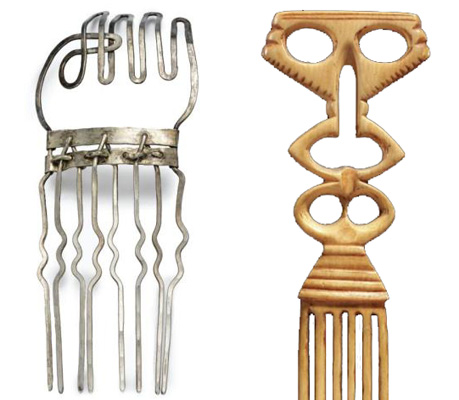There have been some lovely French combs available from various shops online. On Feb 18, a beautiful French art nouveau enamelled bird on a tortoiseshell pin, offset with glass stones, sold for $513. Too much for me in one bite. I didn’t win. :-( But this one is definitely worth noting. It was sold by ancient-arts and bought by stealthwon. I think someone could build an entire collection around birds if they wanted to.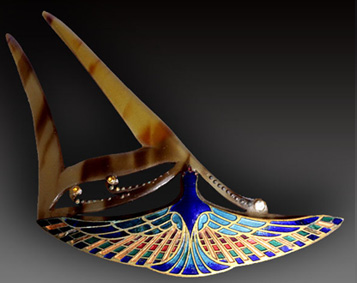
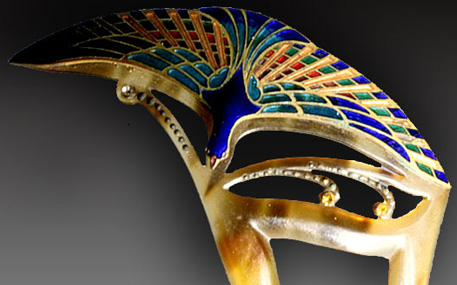
A friend of mine bought this c. 1870 French Fleur de Lis comb, which is made of shell with gold accents, on Ruby Lane for $350. I think it’s especially elegant.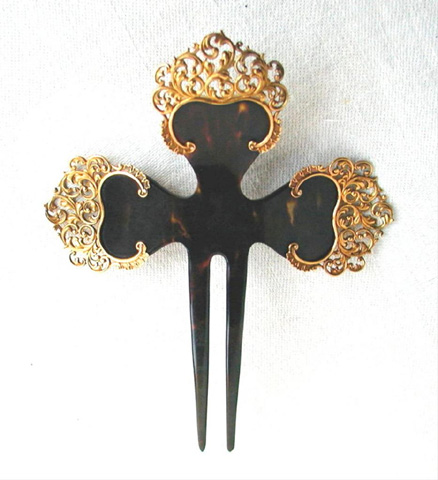
This is a French brass hair pin, c. 1880, which was sold at my friend Sue Marie’s shop LeBoudoir on Ruby Lane for $300. The hair pin depicts wheat. I really like this one because of its unusual subject. I should have bought it.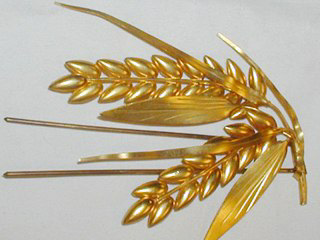
And last but not least, is this lovely French tortoiseshell back comb, c, 1880, which I’m arranging to buy from Ruby Lane. I like the shape. I have an English back comb, and I love getting similar things from different countries to compare how different cultures approached the same design challenge.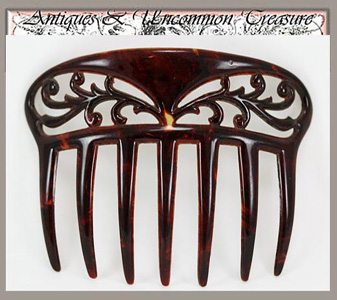
Monthly Archives: September 2009
Victorian Garnet Hairpins
Hi Peeps :-) I have been so busy with work and writing a book, there hasn’t even been a moment to blog! I am so sorry about this. A lot has happened in the comb market since my last post. I guess I’ll start with the lovely stuff that has been sold on ebay, and then move to other venues. The first thing I’d like to talk about is Victorian garnet hairpins, c. 1880. The small garnet tiara cluster on a two-pronged hairpin is a common design, but they are all beautiful. Maybe it would help collectors if a fair price could be recommended. On January 21, an ebay member paid $750 for this bohemian garnet tiara hinged on a two-pronged hairpin of clarified horn: 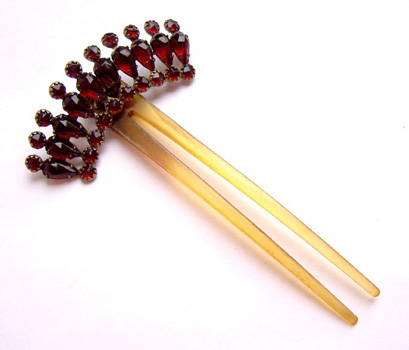
Antiques and Uncommon Treasure on Ruby Lane is selling this garnet tiara hinged to a two-pronged tortoiseshell hairpin for $295. She also has a matching garnet ring and bracelet to complete a set, each sold seperately. 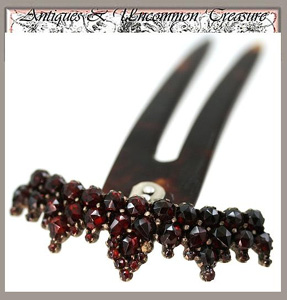
This ebay seller did not meet her reserve when buyers only bid $179 for this garnet tiara hinged to a 2-pronged tortoiseshell comb on Feb 7.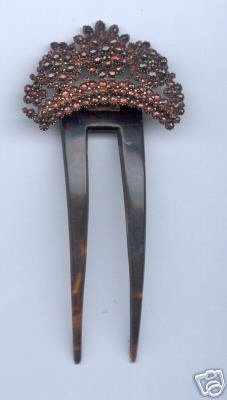
And an ebay seller tried to sell this garnet tiara, tortoiseshell hairpin for — if I remember correctly — around $1000. Please correct my memory if you saved this auction. I only saved the photo. Why $1000? The box is Faberge. Is there documented provenance placing that hairpin in that box? No. I guess if I feel an item is worth $300, and I’m going to pay $700 for a box, I’d want peer-reviewed documentation placing that object in that box by that jeweler. No one bought this piece.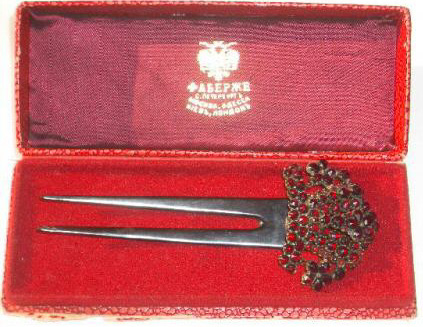
I’m going to go out on a limb. ;-) I think the $300 range is a fair price for garnet hairpins of this style and size, in excellent condition. If you pay over that, it could be auction frenzy, provenance that it came from a famous jeweler, or the name of the jeweler with the year marked on the back. Makers marks most certainly add value. How much is up to you.
Some Lovely Things on Ebay
There have been a few beautiful things sold on ebay recently.
A Chinese hand-carved ivory comb of immaculate intricacy sold for $230.41 on Nov. 22. You may refer to item #290051280139.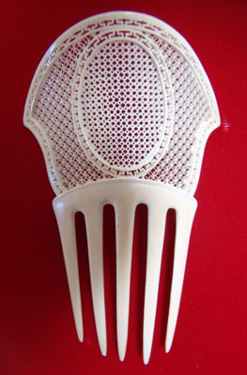
A Late Edo tortoiseshell comb with gold maki-e paint and coral cabachons sold for $150 on Dec 10. This was a good buy. 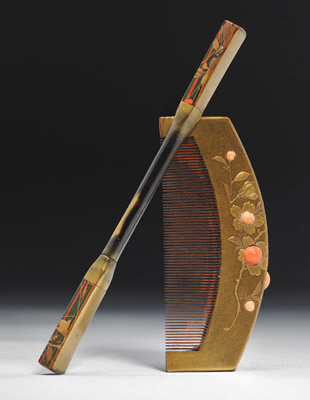
A Victorian heavy gold plate, filligreed tiara with real red coral beads, c.1850, sold for $394 on Dec 11. It is very rare for all the tiny coral beads inbetween the gold plate to be in place and undamaged. Victorian jewelers also made combs in this style with seed pearls. Provenance: It was bought by Charles Stirling, 1789 – 1867. His grandchildren sold it through seller auctionit-ca, who lists the family’s entire history. 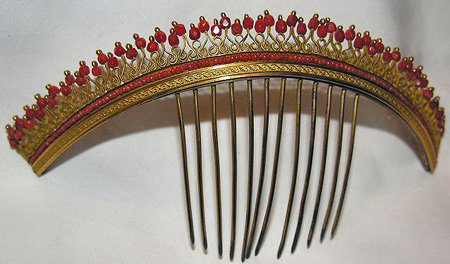
An opal tiara of the same quality was also sold by Stirling’s grandchildren through auctionit-ca for $335. It has filligree roses and 17 opalite stones. I think I know the person who bought it. Oh! It was ME! ;-P Want to hear a tragedy? The seller offered this comb for a Buy-It-Now of $200 in the beginning of the week, and I bid on it instead. I am currently on the train to ebay hell, where I will be in a room full of ebayers yelling at me for eternity for this, but it’s still beautiful, and I’m thrilled to have won! 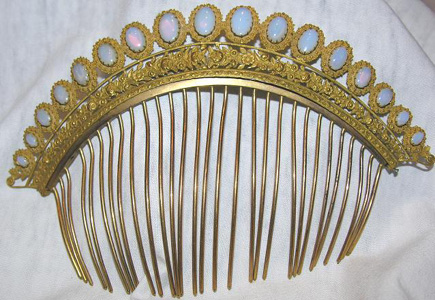
This beautiful Chinese ivory hair pin sold for $305.01 on Dec 10. I think that’s high for this. If you look at the comb titled “Ivory Birds in a Flower Garden” in my bird comb post, you’ll see an entire comb in the same design. 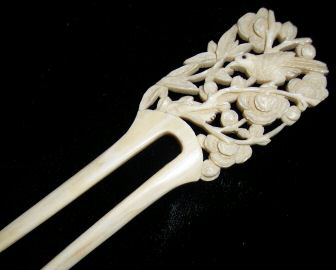
A Beautiful British Revivalist Tiara
I’m in a Sotheby’s tiara mood I guess. This gold and turquoise tiara was signed by Carlo Giuliano c.1870 and numbered 37. Giuliano was a British jeweler, b.1831, d, 1895, who was a leader in the Revivalist Movement, sensitively interpreting Renaissance jewelry to suit late-19th-Century tastes. The tiara is openwork gold, decorated with five circular clusters of round turquoise cabochons, spaced by entwined scrolls topped by beads. I think it’s gorgeous. Sold for $27,600 on Dec. 6, 2006.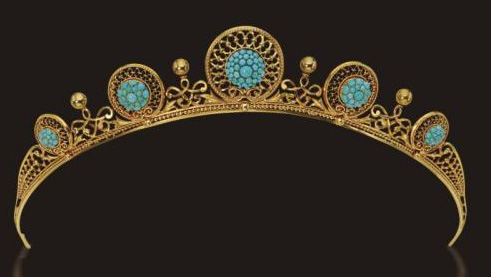
Winged Tiaras
Whether they were inspired by Wagner’s flying Valkyries, or the Aesthetic and Revivalist Movements, some tiaras had wings. Here are three beautiful examples.
This tiara consists of a a pair of wings on a frame, feathers closely set with diamonds, and patches of translucent blue enamel. They are adjustable to any angle and can be taken off the frame to wear as brooches, individually or as a pair. Women would wear a tiara like this to a performance of a Wagner opera in Paris or London c. 1905.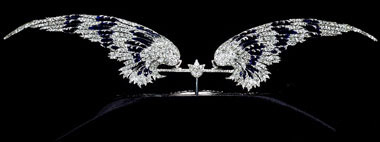
From a Sotheby’s auction, this British Revivalist tiara was designed as a pair of wings pavé-set with diamonds, the tips of translucent green enamel, flanking a star ruby cabochon, supported by a pair of diamond-set coiling serpents with small round cabochon ruby eyes. It was made by Carlo and Arthur Giuliano, c. 1895. Sold for $36,000 on Dec. 6, 2006.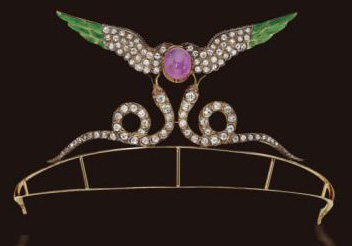
From The Tadema Gallery, this rare Child & Child tiara from the Aesthetic Movement is made of gold, silver, plique-a-jour enamel and crystal. It has a monogram of two C’s and a sunflower and was made c. 1895. It is listed in a number of books, including Two Centuries of Tiaras, Museum of Fine Arts, Boston. Price Range: 20,000 UKP and up. 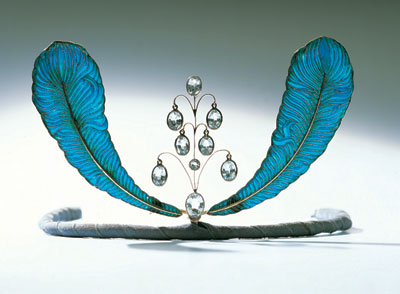
Final Prices at Sothebys
We’ve been following a lot of combs sold at Sotheby’s auctions. I thought it might be useful to list their final sale prices to get a sense of the comb market. Like any antique, the highest prices went to pieces that were made by the hands of a master who changed the way the world thought about art. The great masters made combs-as-jewelry and combs-as-ideas. Each thumbnail photo will be linked to the original post, so everyone can see the description.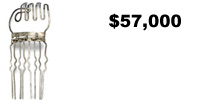
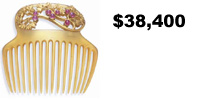
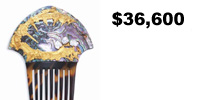
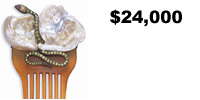
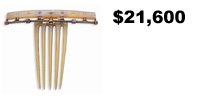
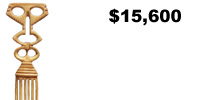
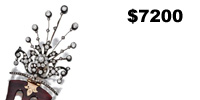
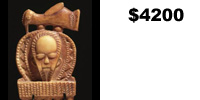
Chinese Combs
I have focused much attention on Japanese artists, but China has a magnificent comb tradition of its own. Chinese artists used feathers from the kingfisher bird, now endangered. On most combs the feathers have worn off. There are a lot of Chinese sellers on ebay now, who advertise kingfisher hair pins. I am not so sure these pins are authentic. How would sellers be able to produce these hairpins in the quantity needed for a business, if the source material were rarely available? “These are mysteries, Straker,” as P.G. Wodehouse would say. However, here is a picture of a genuine kingfisher feather Chinese comb. It is very rare to find one in this condition.
This Chinese hair ornament was made by Tinfook, c. 1890, and was given to the Cooper Hewitt National Design Museum by Mrs. Randolph Hearst, Jr. It is made of gold, jade, and pearls.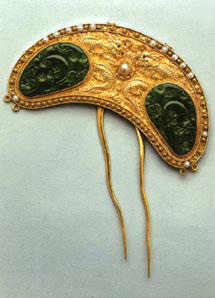
Some Lovely Things on Ebay
Here is the most recent set of beautiful combs, which were listed on ebay. Also listed was a drawing of a horn hair comb with notes in Rene Lalique’s own hand, from his family’s collection.
Tortoiseshell comb, c. 1850, with intricate hand-carved openwork design and real rubies, diamonds, and sea pearls. It sold for $405 on Nov. 16. 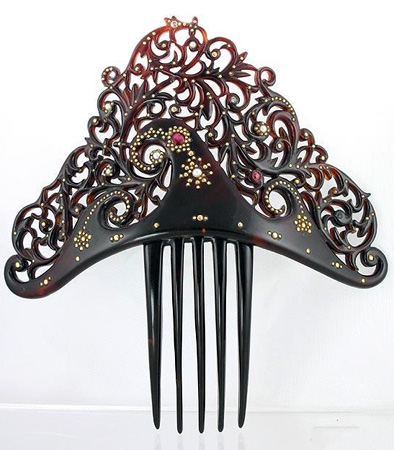
Joseph Rodgers’ hallmark is on this Sterling silver comb, c. 1898. The comb is small, about 3.34″ wide by 3.1″ high. It sold for $68.02 on Nov. 12. 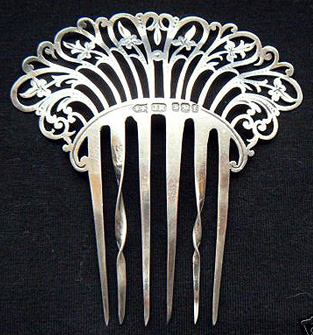
Design for a horn hair comb, ink and watercolor on BFK Rives parchment paper, with annotations in Lalique’s hand, upper right, c. 1900. (Provenance: Lalique Family collection.) It sold for $4000 on Nov. 17. 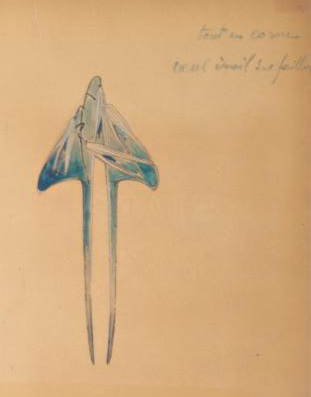
Mary’s Bonaz Comb
I am delighted to present this post by Mary Bachman, president of the Antique Comb Collectors Club. She wrote one of the definitive books on European combs called, “A Collectors Guide To Hair Combs.” I’d recommend buying this book because she has a beautiful collection, and it is also a price guide.
Mary wanted to share one of her Auguste Bonaz combs with us. She writes, “Auguste Bonaz was a designer of hair ornaments during the early 20th Century. His designs are very popular with collectors. His company was located in Oyonnax in Eastern France where he designed for leading jewelry makers. After World War I his business expanded and the demand for his combs continued to grow. Even though ladies were bobbing their hair, his combs continued to be popular. His designs are varied and delightful. Bonaz died in 1922, but his wife carried on his business using only his original designs. His nephew managed the business until 1982 when it finally closed. (Reference: Jen Cruse article in the Antique Comb Collector, June 2000).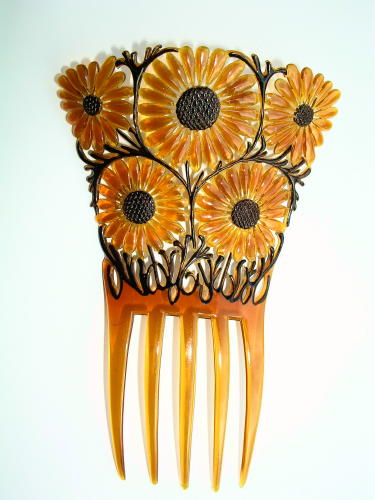
Open Designs
LEFT: From the estate of Francis J. Whitney comes this silver hair comb made by Alexander Calder himself, c. 1948. The work is registered in the archives of the Calder Foundation, New York, under application number It sold for $55,000. RIGHT: An African ivory comb from the Tshokwe tribe, composed of three tiers of intricate openwork, geometric design above the flared shoulder and thin tines; varied creamy patina. It is listed in Robbins and Nooter 1989: 549, figure 1491. Price Estimate: $2000 to $3000. 